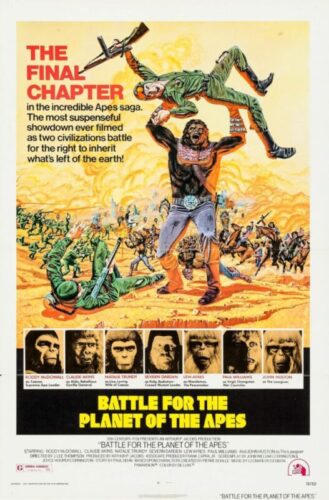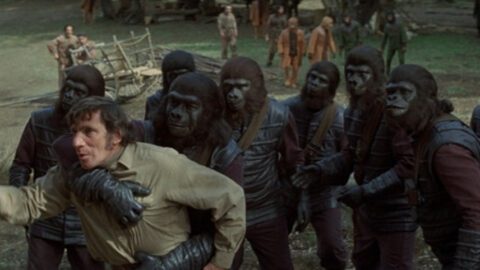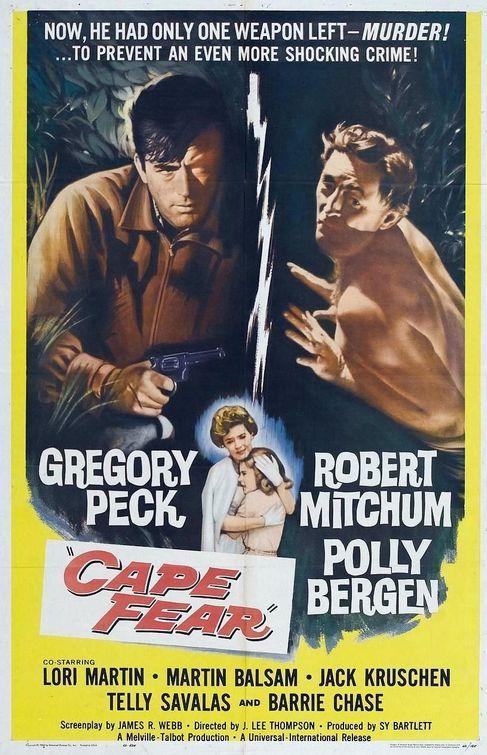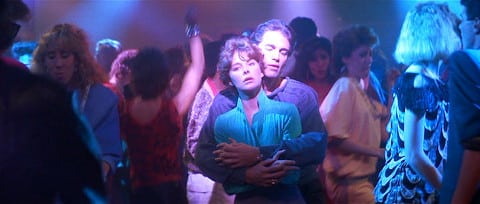Battle for the Planet of the Apes
Directed by: J. Lee Thompson
Written by: John William Corrington, Joyce Hooper Corrington, Paul Dehn
Starring: Claude Akins, Natalie Trundy, Roddy McDowall, Severn Darden
USA
AVAILABLE ON BLU-RAY, DVD and DIGITAL
RUNNING TIME: 93 mins / 83 mins
REVIEWED BY: Dr Lenera

It’s the early 21st century and a global nuclear war has destroyed human civilisation, leaving apes as the rulers. Chimpanzee Caesar, who lives with his wife Lisa and their son Cornelius, is trying to cultivate peace between the apes and remaining humans, but is opposed by the aggressive gorilla General Aldo, who wants to imprison the humans who freely roam Ape City while doing menial labor. When his human friend MacDonald, Keeper of the Archives in the ruins of the Forbidden City, says that the planet will come to an end, Caesar travels there to find archived footage of his parents, not knowing that the place is inhabited by a group of mutated and radiation-scarred humans living there under the command of Governor Kolp, the man who once captured Caesar. Caesar and his party view the recordings of his parents, learning about the future before they are forced to flee when Kolp’s soldiers hunt them. Back at Ape City, things are getting worse….

Although this follows the fourth entry Conquest Of The Planet Of The Apes, there seems to be an entire film missing in between. Conquest ended with the apes just beginning to revolt, this begins with the revolution over and peace with the humans established, not to mention an entire nuclear war having occurred in the interim. But or course with the declining budget being given to these films due to Fox having some major flops even though these Apes movies were guaranteed hits, there wasn’t much chance of that film being made, so instead we move forward a bit more so that we’re in a world much more like the one in Planet Of the Apes and Beneath The Planet Of The Apes, except of course that it could never quite be the same, because a few events occurred that didn’t happen in the previous version of this sequence of events. And actually, as one thinks about this, a major flaw presents itself. We’re not actually supposed to be as far in the future for all the apes to talk, be civilised and even wear that cloth and leather clothing familiar from the first three films, yet somehow they’ve become like this after just, it seems, a couple of decades. But then screenwriters John William and Joyce Hooper Corrington admitted that they hadn’t actually seen any of the previous films, so perhaps we shouldn’t expect everything to tie in. Rather lacking in freshness and ideas, it all seems a bit tired while social commentary is virtually forgotten, though it proceeds at a fast enough pace to partly compensate. However, the low budget is ludicrously low for what had to be shown on screen. All we see of Ape City are a few buildings, armies are absurdly small, a battle keeps on repeating the same explosion from different angles, and the ape masks look really rubbery and mouths barely move. One really feels for director J. Lee Thompson, who returned from the previous episode, trying to work with what little he was given.
Scripter of all the previous sequels Paul Dehn was hired to provide a story treatment, but then fell ill and had to withdrew from the project. John William Corrington and Joyce Hooper Corrington were brought in after the success of their film The Omega Man [another Charlton Heston future-set effort], though Dehn was able to do a final polish on the script, claiming that he rewritten 90% of the dialogue and added a new final shot which which Joyce Corrington said was “Stupid, it turned our stomachs when we saw it.” Also cut from the script was a hybrid ape-human child because of the implications of bestiality. Governor Breck from Conquest of the Planet of the Apes was originally planned to return as the villain, but actor Don Murray wasn’t interested. However, Severn Darden was available to come back, so Breck’s former security chief Kolp was promoted to main villain. Thompson had agreed to do the film without a script in place but was unhappy with both the script and the small scope of the production. Shot entirely on the Fox Movie Ranch, now Malibu State Park in Hollywood, Battle for the Planet of the Apes was the second-to-last film produced by Arthur P. Jacobs who died less than two weeks after its release. It still did well at the box office, cut by ten minutes which were later restored to some versions [more on that later] but Fox had already decided to move the series to TV so no more movie sequels were planned. This is supposedly the film that inspired Tony Mendez to create the operation “Argo” during the Iran hostage crisis from 1979 to 1981 in which he traveled to Iran in disguise as a film producer and had the hostages disguised as a film crew in order to flee the country, as shown in the film Argo.
We begin in the year 2670 and meet the Lawgiver, whose writings and quotes formed the basis of the apes’ system of laws and customs as seen in the first two films, particularly with regard to humans, whom the Lawgiver had declared “the devil’s pawn”, to be shunned and driven out, if not destroyed outright. The unmistakable voice of John Huston gives us some background along with five minutes of footage from Escape and Conquest. None of the previous films felt that they had to do this, assuming that most viewers would have seen the previous films, so the reason they did it here was probably just to pad the film out without spending too much money. Then we get several minutes of an ape riding on a horse behind the opening titles. The ape is General Aldo, who doesn’t like the fact that the humans, while still inferior, have their freedom. A human teacher is doing his best, but when he points out that Aldo’s writing is bad and Also screws the piece of paper up, the teacher says “No” – and that’s not good, because it’s the law that a human should never say no to an ape. Aldo wrecks the classroom and chases the teacher but is eventually stopped by Caesar. The increasing hostility by Aldo to Caesar is certainly well done, but when Caesar, MacDonald and a wise orangutan called Virgil journey to the remains of the Forbidden City, there’s little suspense and no build up to or surprise revelation of the Mutants who are, of course the ancestors of the ones in Beneath, which neatly brings me to the two major scenes that were removed. They both have the Mutants preparing to fire the Alpha-Omega missile we saw in the earlier movie but then deciding not to. They add some tension, but were better off cut because otherwise we have to believe that the Forbidden City was also none other than New York despite we not having been given any indication of this before and the set looking quite different, in one of several bafflingly poor writing decisions.

The Mutant general Kolp and Caesar recognise each other as former antagonists, and Kolp thinks that Caesar is planning to finish off all mutant humans. I like how, among the Mutants, there’s a character with reason, a guy called Mendez, and I suppose it would have been nice to see, as we do in the extended version, Mendez becoming leader seeing as Beneath suggested to us that all their leaders were called Mendez, though we would have still had to show that bomb. Our three escape, but Kolp now wants to find and destroy all the local apes, so he masses an army, though we only see a small number of soldiers at a time, and Thompson and cinematographer seems to give up trying to disguise the minimal people after a while, with several shots of a few men descending from a hill top with nobody behind them; sharper cutting would of course have helped immensely here. Back in Ape City things are getting worse, and Kolb becomes responsible for a terrible crime against Caesar, though the irony is that, without Kolb and his gorillas who are the main fighting force, the mutants would have overran Ape City pretty quickly. The battle, despite being absurdly limited in scale, does have its bits of excitement. It had nearly two minutes removed for the theatrical cut, but doesn’t suffer for this, the uncut version of the battle containing too many shots of people just running around. The remaining cut material consists of other minor scene extensions, the most notable being the death of some of the major villains. For some reason, only the North American version of the Planet Of the Apes box set contains this version; other editions including the UK one frustratingly presents the footage as deleted scenes. I guess the reason for the lack of its inclusion must be a rights issue.
Battle is closest to Beneath out of the all the Ape films, despite lacking it’s darkness and brutality. It’s also a bit disjointed, the various elements feeling thrown together, but the very fast pacing is certainly a compensation. After all, there’s no attempt at any kind of depth until the end, even though some of the dialogue sometimes tries to give the impression that we’re watching a more philosophical film than we actually are. So to enjoy Battle, it’s best to go in not expecting the social commentary and wit that’s been a major ingredient of three of the previous entries and was a minor ingredient of the second, and to just attempt to enjoy it as a more kid-friendly precursor to all those post-apocalyptic actioners that came in the wake of Mad Max 2: The Road Warrior. I like the way that the mutant army uses cars and buses, though the violence is downplayed as to be almost ridiculous in the way that it avoids showing any blood whatsoever. This was done to get a ‘G’ [equivalent to ‘U’ in the UK] rating, and as a response to criticisms of Conquest being too vicious [though it had to be vicious to serve its story and to get its points across] and aimed more at adults than kids, but they kind of went too far. Still, Severn Darden as Kolp, replete with cape with turned up collar, seems to play his role with more and more conviction as the film moves along, while Claude Atkins is nicely hissable throughout as Aldo, ironically named after the ape that led the revolt against humans in the original timeline though I wish that he’d been given a moment or two to justify his hatred or humans who in the past, as we have seen, treated apes very poorly. In fact in my head are several ideas that would give Battle some weight.
Still, while Aldo’s final confrontation with Caesar is weakly staged – a bit of slow tree climbing followed by a lunge and a fall – it has some power because, instead of us properly enjoying this revenge like we would expect, we finally see Caeser as we don’t want to see him. Thoughout, he’s preached peace and love, but is now a violent avenger, and it ain’t nice to see. Roddy McDowall yet again gives a detailed, emotive performance through all that makeup. We can see and feel his torment and his transition; his work on these films really is remarkable, though on this one he’s hampered by his lame mask which really shouldn’t have been given as many closeups at it did. I keep harping on about the low budget because it really does hold things back, though some matte paintings, especialy of the Forbidden City, are quite good. Leonard Rosenman of Beyond returned to soundtrack duties, though without the heavy percussion he employed before. His score includes some solid marching and fighting motifs, plus some gentle pieces to accompany the death of a young chimp and the film’s coda, though the slightly discordant nature of Rosenman’s writing prevents full emotion from coming through and melodic development. Said coda shows ape and human children playing, though one pair is fighting, the film leaving the viewer to ponder on what will become of the perfect ape society. Will it actually degenerate to what it would become in Planet Of The Apes, or would all the positive changes in this movie avert that awful future and the destruction of the Earth?!? Depending largely on whether you tend to think positive or negative, it’s a nice, questioning conclusion that rounds off the first cycle of Ape films quite well, even though this film remains easily the weakest of the lot – though of course it’s still an Ape movie, so I always find some enjoyment out of it.
Rating: 














Thank you so much for your commentary. I have loved all of the Ape films (and yes, even the tv show!) since I was a kid, and this is a really interesting backstory.